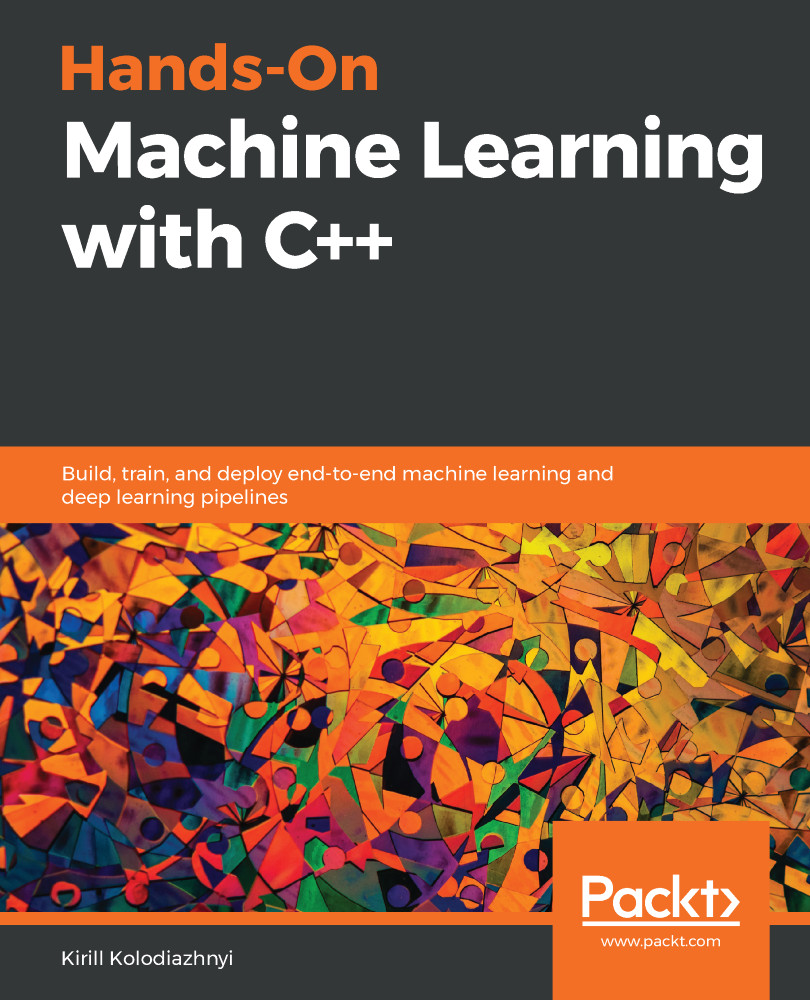Eigen is a general-purpose linear algebra C++ library. In Eigen, all matrices and vectors are objects of the Matrix template class, and the vector is a specialization of the matrix type, with either one row or one column. Tensor objects are not presented in official APIs but exist as submodules.
We can define the type for a matrix with known dimensions and floating-point data type like this:
typedef Eigen::Matrix<float, 3, 3> MyMatrix33f;
We can define a vector in the following way:
typedef Eigen::Matrix<float, 3, 1> MyVector3f;
Eigen already has a lot of predefined types for vector and matrix objects—for example, Eigen::Matrix3f (floating-point 3x3 matrix type) or Eigen::RowVector2f (floating-point 1 x 2 vector type). Also, Eigen is not limited to matrices whose dimensions we know at compile time. We can define matrix types that will take the number of rows or columns at initialization during runtime. To define such types, we can use a special type variable for the Matrix class template argument named Eigen::Dynamic. For example, to define a matrix of doubles with dynamic dimensions, we can use the following definition:
typedef Eigen::Matrix<double, Eigen::Dynamic, Eigen::Dynamic> MyMatrix;
Objects initialized from the types we defined will look like this:
MyMatrix33f a;
MyVector3f v;
MyMatrix m(10,15);
To put some values into these objects, we can use several approaches. We can use special predefined initialization functions, as follows:
a = MyMatrix33f::Zero(); // fill matrix elements with zeros
a = MyMatrix33f::Identity(); // fill matrix as Identity matrix
v = MyVector3f::Random(); // fill matrix elements with random values
We can use the comma-initializer syntax, as follows:
a << 1,2,3,
4,5,6,
7,8,9;
This code construction initializes the matrix values in the following way:
We can use direct element access to set or change matrix coefficients. The following code sample shows how to use the () operator for such an operation:
a(0,0) = 3;
We can use the object of the Map type to wrap an existent C++ array or vector in the Matrix type object. This kind of mapping object will use memory and values from the underlying object, and will not allocate the additional memory and copy the values. The following snippet shows how to use the Map type:
int data[] = {1,2,3,4};
Eigen::Map<Eigen::RowVectorxi> v(data,4);
std::vector<float> data = {1,2,3,4,5,6,7,8,9};
Eigen::Map<MyMatrix33f> a(data.data());
We can use initialized matrix objects in mathematical operations. Matrix and vector arithmetic operations in the Eigen library are offered either through overloads of standard C++ arithmetic operators such as +, -, *, or through methods such as dot() and cross(). The following code sample shows how to express general math operations in Eigen:
using namespace Eigen;
auto a = Matrix2d::Random();
auto b = Matrix2d::Random();
auto result = a + b;
result = a.array() * b.array(); // element wise multiplication
result = a.array() / b.array();
a += b;
result = a * b; // matrix multiplication
//Also it’s possible to use scalars:
a = b.array() * 4;
Notice that in Eigen, arithmetic operators such as operator+ do not perform any computation by themselves. These operators return an expression object, which describes what computation to perform. The actual computation happens later when the whole expression is evaluated, typically in the operator= arithmetic operator. It can lead to some strange behaviors, primarily if a developer uses the auto keyword too frequently.
Sometimes, we need to perform operations only on a part of the matrix. For this purpose, Eigen provides the block method, which takes four parameters: i,j,p,q. These parameters are the block size p,q and the starting point i,j. The following code shows how to use this method:
Eigen::Matrixxf m(4,4);
Eigen::Matrix2f b = m.block(1,1,2,2); // copying the middle part of matrix
m.block(1,1,2,2) *= 4; // change values in original matrix
There are two more methods to access rows and columns by index, which are also a type of block operation. The following snippet shows how to use the col and the row methods:
m.row(1).array() += 3;
m.col(2).array() /= 4;
Another important feature of linear algebra libraries is broadcasting, and Eigen supports this with the colwise and rowwise methods. Broadcasting can be interpreted as a matrix by replicating it in one direction. Take a look at the following example of how to add a vector to each column of the matrix:
Eigen::Matrixxf mat(2,4);
Eigen::Vectorxf v(2); // column vector
mat.colwise() += v;
This operation has the following result:  .
.


































































 norm for
norm for  . Usually, we use more concrete norms such as an
. Usually, we use more concrete norms such as an  norm with p = 2, which is known as the Euclidean norm, and we can interpret it as the Euclidean distance between points. Another widely used norm is the squared
norm with p = 2, which is known as the Euclidean norm, and we can interpret it as the Euclidean distance between points. Another widely used norm is the squared  . The squared
. The squared  norm is more suitable for mathematical and computational operations than the
norm is more suitable for mathematical and computational operations than the  norm with p=1, which is commonly used in ML when we care about the difference between zero and nonzero elements.
norm with p=1, which is commonly used in ML when we care about the difference between zero and nonzero elements. , where I is an identity matrix. The identity matrix is a matrix that does not change any vector when we multiply that vector by that matrix.
, where I is an identity matrix. The identity matrix is a matrix that does not change any vector when we multiply that vector by that matrix.

 .
.






















